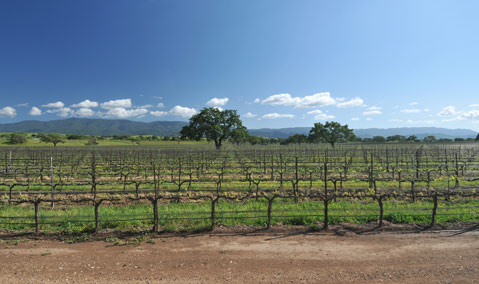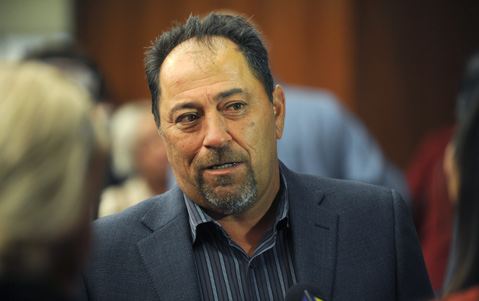Feds Approve Chumash Camp 4 Plans
Appeals All but Certain

In what the tribe labeled a “landmark ruling” that county representatives vowed will be appealed, the federal Bureau of Indian Affairs (BIA) granted the Santa Ynez Band of Chumash Indians’ controversial plan to annex 1,400 acres of Santa Ynez Valley land — known as Camp 4 — into its existing reservation. The 36-page ruling came on Christmas Eve but not as a surprise to the players involved, given the favorable 557-page environmental analysis released by the agency in October.
The approval marks one of the final steps in a saga that heated up nearly 18 months ago when the Chumash submitted their annexation application to the BIA. But a bevy of concerns expressed by valley residents, environmental groups, and the County of Santa Barbara over the tribe’s takeover of the property — especially in the wake of fast-moving plans to expand the existing reservation to include a 12-story hotel tower — could mean appeals that may tie up the property’s future for years to come.
Last month, the Board of Supervisors voted 3-2, with Supervisors Salud Carbajal and Steve Lavagnino against, to appeal the aforementioned environmental study — which county officials argued wasn’t thorough enough — and initiate legal proceedings should the BIA grant the tribe’s request. On Tuesday, County Counsel Michael Ghizzoni noted that vote and said the county has 30 days to file its appeal with the federal Interior Board of Indian Appeals.
Third District Supervisor Doreen Farr, who represents the valley, said that she and other county officials “will continue to do everything that we think is right to protect the interests” of valley and county residents. “We knew from the beginning that the odds were pretty stacked against us,” Farr said, noting that the BIA hasn’t once denied a fee-to-trust application. “That says a lot right there.” (A sentence in the ruling by the BIA, accused by many Camp 4 opponents of being a rubber-stamp agency, mistakenly references San Diego County instead of Santa Barbara County.)

Tribal Chair Vincent Armenta cheered the BIA’s decision, saying that the agency conducted a “thorough” study of the tribe’s plans — their only plans, Armenta has repeatedly stated — to build 143 housing units for tribal members and descendants on the land, which the tribe bought for $40 million from Fess Parker in 2010. The ruling, Armenta said, “places us one step closer to getting our Camp 4 land placed into federal trust. The sooner the land is placed into trust, the sooner we can move forward on building homes on Camp 4 for our tribal members and their families.”
Armenta has said previously that he would expect appeals in the face of an approval, pointing to the nine years of legal back-and-forth it took to annex 6.9 acres of land across the street from their reservation. That’s where federal legislation — pushed by the tribe and introduced in the fall of 2013, after the supervisors’ vote against annexation, by northern California Representative Doug LaMalfa — could come into play, Armenta has said. While that particular bill, HR 3313, is now technically dead, it could be revived in the new session of Congress. Kevin Eastman, a representative for LaMalfa, said the congressmember was “pleased to see the tribe’s effort to address housing needs moving forward and he’ll continue to support it legislatively until the situation is resolved.”
Representative Lois Capps, who expressed her disapproval for the bill when it was introduced, maintaining it should be handled at a smaller scale, issued a statement on the BIA’s approval. “This announcement is the next step in the Bureau of Indian Affairs fee-to-trust process, which began last year when the Chumash filed their application,” she said. “I will continue to work with members of the community as this process moves forward.”
But where the Chumash insist that they don’t want to build another casino on the land — HR 3313 included a no-gaming clause — valley residents and county officials have been vocal about what could happen once the land is no longer the county’s. With annexation, the 1,427 acres — which aren’t contiguous to, but sit 1.6 miles away from, the reservation — would be removed from the county’s tax rolls. According to the BIA, the land contributed more than $83,000 to the county’s $632 million property-tax pot in 2012-2013; if the parcel goes into trust, the county could lose up to $311 million in property taxes over the next 50 years.

Most worrisome to opponents is that annexation of Camp 4 — so named, Armenta said, because it was the fourth stop on a route between San Francisco and Arizona during the Stagecoach era — will also remove the land from the county’s strict planning regulations. Those concerns have only amplified since the tribe presented plans to grow the casino-resort on the existing reservation to include a 12-story hotel wing, which has drawn questions about, among other things, water use, fire protection, and aesthetics. Many, including Supervisor Farr, have suggested that the tribe, if its only intention is to build housing, go through the normal county process. “We’ve said, ‘If housing is what you want, let’s talk,’” Farr said, adding that one of her main concerns is that the tribe “never established need” for the fee-to-trust route.
In its ruling, the BIA shot down that argument, calling it “unreasonable” to “specify why holding the land in trust is more beneficial for tribes.” Further, the BIA stated, it “relies on the tribe’s assurances regarding the proposed use and is not required to speculate about possible or potential uses.”
Overall, the ruling continued, the BIA granted the approval because the tribe made a successful case for its need for additional land. Eighty-three percent of the tribe’s population — 136 tribal members and 1,300 descendants — aren’t living on tribal property and the majority of the existing 137-acre reservation is already developed, the agency wrote. “The Santa Ynez Band of Chumash Mission Indians is a strong functioning tribal government with many capabilities and a growing economy,” the report stated. “These are some of the tools necessary to sustain future generations, increase the tribal enrollment, and build an ever-stronger functioning tribe in the future. Another critical element is land as a basic resource.”
As it is now, the 1,400 acres is under a state Williamson Act contract through 2022, meaning it is intended to be used solely for agriculture. County Counsel Ghizzoni said that the tribe has indicated that it will “respect” that contract. As far as what the tribe could do with the land during an all-but-certain appeals process, Ghizzoni said that “depends on what process the BIA follows with an appeal.”
Armenta, in an interview prior to the approval, bristled at the mention of opponents’ views, attributing them to a small but loud minority of valley residents. “Probably 10 people want to kill me; thousands want to give me a hug,” he said, noting the few people who attended a public meeting on the expansion plans. At the time, he derided the supervisors’ ahead-of-time vote to appeal any approval, bringing the issue back to what he said is the need for the county to treat the tribe as its governmental equal. In August 2013, after the annexation application was submitted, Supervisors Carbajal and Lavagnino were on the losing end of a vote to support such a relationship.
Moving forward, Farr said her office will be sending out the latest information to constituents. She will also, she said, continue working with the California State Association of Counties to beef up counties’ input when tribes with state compacts issued in 1999 look to renew them, as the Chumash will do by 2020.
–



